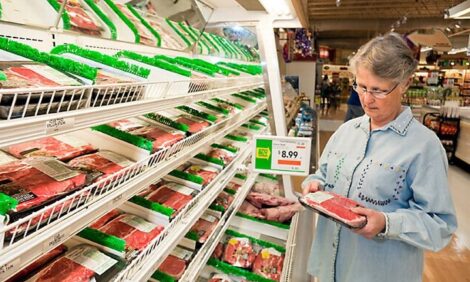



Pork Stocks in Cold Storage Build
US - According to the latest USDA ’Cattle on Feed’ survey, the total inventory of cattle on feed as of October 1 was 10.266 million head, 0.4 per cent higher than a year ago but about .7 points lower than the average pre‐report estimates, which were indicating a 1.1 per cent increase. The 0latest Daily Livestock Report, published by Steiner Consulting Group, explains.Keep in mind that the inventory numbers tracked by the monthly survey are only those in operations that have a capacity of +1000 head of cattle or more. As we have noted before, it is likely that today we have more cattle on feed in smaller operations and will have to wait until the January survey to capture the total on feed supplies.
The smaller than expected inventory number was due to smaller than expected placements in September. Placements of cattle onto feedlots last month were estimated at 1.905 million head, 36,000 head (‐1.9 per cent) less than a year ago and 109,000 head (‐5.4 per cent) less than two years ago.
One factor that also may have impacted the smaller than expected rate of placements last month is that grass supplies remain plentiful and in excellent shape, thus providing an incentive for cow‐calf operators to hold on to their calves a bit longer.
Feeder cattle prices (October futures) in mid-August were trading around $147/cwt but by the end of September were in the $120 range, an 18 per cent price drop in just a few weeks. Given the value erosion, it should not be a surprise that cow‐calf operators were reluctant sellers, especially with 52 per cent of pastures and ranges (as of Sep 26) in good or excellent condition.
Looking at the breakout of placements by state the biggest variance relative to our earlier expectations was Nebraska. According to the USDA survey, placements in that state in September were 470,000 head, 8 per cent lower than a year ago.
Prior to the report we expected placements to be up 4 per cent. Total placements in Nebraska for the last three months have been a combined 1.285 million head, 1.9 per cent lower than a year ago. For the entire country, placements in the last three months have been a total of 5.501 million head, 7.4 per cent higher than last year. Keep this in mind when considering the latest placement numbers.
Feedlots have been quite aggressive in placing cattle during July and August and the September shows that they were running a bit ahead of schedule. The reality is that there are more calves on the ground than one or two years ago and this will continue to bolster feedlot supplies going forward.
There is still plenty of meat in cold storage and, in the short term, this may keep prices in check. Total beef, pork and poultry supplies in refrigerated warehouses at the end of September were estimated at 2.443 billion pounds, 1.6 per cent larger than the previous month and 11 per cent higher than the five-year average.
Inventory build in September was +2.1 per cent compared to the previous month compared to a five-year average build of just 0.2 per cent. Boneless beef stocks jumped 9 per cent from the previous month compared to a five-year average monthly build of just 3.3 per cent.
It should be noted that the increase in inventories comes at a time when US beef imports have declined sharply, implying that significantly more domestic boneless beef is ending up in cold storage. This should dampen demand for some beef products in the short term.
USDA does not say what kind of product is in cold storage but we suspect that part of the reason for the increase is due to the oversupply of fat beef trim. Some of this product likely is going into the freezer but it has a relatively short shelf life and we think negatively impact price expectations for later this year and into January‐February.
Total pork inventories were 642 million pounds, 5.4 per cent higher than the previous month and a much faster inventory build than we normally see at this time of year. Total pork inventories are still about 2.1 per cent lower than a year ago.
Given the big increase in slaughter in August and September it is quite impressive that cold storage stocks are lower than last year. We think overall demand for pork remains in good shape and packers have been quite successful in keeping the flow of product moving through the various channels.
Higher exports likely have helped, with September exports currently pegged up 9 per cent from last year (our estimate). However, not all is good in the pork complex. Slaughter in October is expected to be even bigger and exports are showing signs of slowing down.
We expect pork inventories to increase further in October. For now, however, we think markets will view the current report as generally neutral for prices in the short term.
Total chicken inventories were 768.7 million pounds, 3.9 per cent lower than a year ago but still 15.1 per cent higher than the five-year average. Inventory depletion was generally in line with what we see this time of year.
Inventories of leg quarters are now down 18.9 per cent, helped in large part but resurgent chicken exports. Breast meant inventories, on the other hand, are still up 7.3 per cent from last year and 29 per cent higher than the five-year average.








